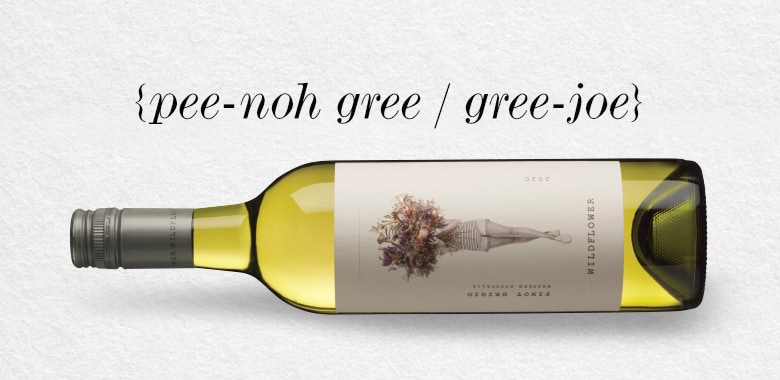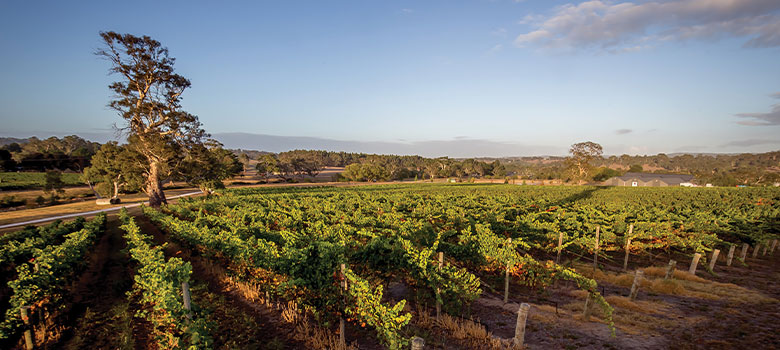
Wine
What is Pinot Gris and Pinot Grigio?
Pinot Gris and Pinot Grigio – wines of the same variety but made in different styles, which we affectionately call Pinot G ¬– have become one of Australia’s favourite white wines for their apple and pear characters and refreshing qualities.
But how do you pronounce Pinot Grigio? What is the meaning of Gris and Grigio? And when it comes to taste, which is sweeter, Pinot Grigio or Pinot Gris?
In this varietal deep dive, we look at the origins of Pinot G in Australia, explore the differences between the two styles, reveal where it grows best here, and share some of our favourite food matches that make a perfect pairing with Pinot G. Enjoy!
Shop Pinot G
What is Pinot G? Pinot Gris and Pinot Grigio are the same grape variety, but made in two different wine styles.
What does Pinot Grigio and Pinot Gris taste like? Similar in weight to Semillon, Marsanne and Sauvignon Blanc, Pinot G has lemon, quince, pear and green melon flavours.
What food does Pinot G pair best with? Pair your Pinot Gris and Pinot Grigio with Mediterranean style dishes.
How long can I cellar Pinot Grigio or Pinot Gris? Pinot Gris and Pinot Grigio can be cellared for up to 5 years.
What are the characteristics of Pinot G? Pinot G has a light and dry flavour profile.
Did you know, Pinot Gris and Pinot Grigio is actually a pink/grey skinned mutation of Pinot Noir.
ORIGINS OF PINOT GRIGIO AND PINOT GRIS
A white wine grape variety thought to be a mutation or clone of Pinot Noir, Pinot Gris/Pinot Grigio vines have a typically greyish-blue fruit after which it is named. So with that in mind, what is the meaning of Gris and Grigio? Well, gris and grigio are simply the French and Italian words for grey, respectively. And what is the meaning of Pinot? The word itself is derived from the French term ‘pin’, which means ‘pine’, and this name reflects the tight, pine cone-shaped clusters of grapes that grow on Pinot Noir vines. It’s a fitting name, as the grape clusters have a distinctive appearance that sets them apart from other grape varieties.
Pinot Grigio is most successfully grown in the regions of Friuli, the Veneto and Alto Adige in Northeast Italy where it is picked early and produces a fresh, zesty, racy style with clean savoury characters. When it comes to Pinot Gris, it is popular in Alsace, France, where it is picked riper and therefore has a richer, fuller, plumper profile and is higher in alcohol.
Earliest records of the grape as a distinct variety are from the Burgundy region during the Middle Ages, where it was likely known as Fromenteau. From there it spread to Switzerland and Hungary, where it became a favourite of Emperor Charles IV, and came to be known as Szürkebarát, or ‘the grey monk’.
It remained popular through to the 18th and 19th centuries in France and Germany until a series of unreliable crops and poor yields saw that popularity decline. By the early 20th century, however, vine breeders had created clonal varieties that proved far more reliable and consistent. It’s also been known as Grauburgunder in Germany, Malvoisie in the Loire and Switzerland, and as Pinot Beurot in Burgundy.
Today, Pinot G is grown in over 20 countries with global plantings of around 15,000 hectares, and is highly popular here in Australia in both its Gris and Grigio incarnations.
PINOT GRIGIO AND PINOT GRIS IN AUSTRALIA
Pinot G first arrived in Australia in 1832 as part of the famed James Busby collection. Chris Bourke of Sons & Brothers in Orange mentions that when James Busby imported his collection of grape varieties from France and Spain in the 1830s, what he had thought to be Cabernet Sauvignon was, in fact, Pinot Gris. As with much of Busby’s collection, it didn’t survive.
Today’s Pinot Gris and Pinot Grigio was pioneered on the Mornington Peninsula in the 1980s by Kathleen Quealy and Kevin McCarthy, who recognised the suitability of Pinot Gris to the climate of their Mornington Peninsula vineyard. They’ve since gone on to be considered as pioneers of the variety here in Australia, seen as having set the benchmark for Australian interpretations.

Above: Australian Pinot Gris pioneers, Kathleen Quealy and Kevin McCarthy
In Australia no variety – with the exception of Sauvignon Blanc – has grown more impressively than Pinot Gris/Grigio over the last ten years. In that time, it has moved ahead of Viognier, Verdelho, Muscat, Colombard and Riesling. More of it is produced than any of the major white varieties except for Chardonnay, Semillon and Sauvignon Blanc, and there are in excess of a hundred different labels of Pinot Gris/Grigio on the market in Australia at present. Make no mistake, Pinot G has arrived in a big way.
PINOT GRIGIO VS PINOT GRIS – WHAT’S THE DIFFERENCE?
The essential differences between Pinot Grigio and Pinot Gris arise as result of how their wines are made. “Pinot G is hugely popular with Australian wine-lovers, but there’s still so much confusion surrounding this fresh and fashionable white,” says Adam Walls, Wine Selectors Tasting Panel Co-Chair, Wine Show Judge, and 2019 Len Evans Tutorial Dux.
“To put it simply, both Pinot Grigio and Pinot Gris are made from the same grape variety, but are crafted to produce two different styles.” Adam continues. “Across the two styles, the common aroma and flavour descriptors include apple, pear, strawberry, honey, brioche and nuts.”
Where they differ most is in their textural quality. “Grigio has made a name for itself as a light, crisp wine for early drinking, fresh and zesty with clean savoury characters” explains Adam. “French-style Pinot Gris however is generally known for being a richer, fuller-bodied white, a little higher in alcohol with a smooth, silky texture.”
WHICH IS SWEETER, PINOT GRIGIO OR PINOT GRIS?
Though derived from the same grape variety, the two styles are distinct. Pinot Gris leans towards a slightly sweeter profile, while Pinot Grigio generally tends to be crisper and drier.
Which is fruitier, Pinot Grigio or Pinot Gris? In terms of fruitiness, both exhibit yellow and green fruit flavours. Gris is typically more rich, offering a lush array of flavours, while Grigio exudes a zesty, refreshing fruitiness.
Which is drier, Pinot Grigio or Pinot Gris? When it comes to dryness, Grigio takes the lead, often known for its high acidity and a crisper, drier finish, while Gris carries a touch more residual sugar, resulting in a smoother, rounder taste.
These differences make each style an appealing choice for a range of preferences and occasions.
BEST AUSTRALIAN PINOT GRIGIO/PINOT GRIS REGIONS
According to Wine Australia “While it’s nowhere near the heady heights of Sauvignon Blanc, Pinot G is growing rapidly with plantings of the grape outstripping Viognier, Verdelho, Muscat, Colombard and Riesling, and it’s now nipping at the heels of Semillon.”
One issue for Pinot Grigio and Pinot Gris has been the importance of identifying the places where it can be grown most successfully. Kathleen Quealy believes that, from a local perspective, far too much of the variety has been planted in warm Australian regions for which it is patently unsuitable.
The general consensus is that the cool climate regions of Mornington Peninsula, Tasmania, Adelaide Hills, Orange, King Valley and Great Southern have proven to have the ideal conditions for the production of high-quality fruit, while also allowing winemakers to experiment with styles.
MORNINGTON PENINSULA
Tom Quealy, son of Kathleen and Kevin, says the Mornington Peninsula’s superior suitability for Pinot G comes down to a combination of regional factors.
“It’s the climate – cool, maritime, Indian summers,” says Tom. “It’s the cloud cover and sea breezes. The Red Hill and Main Ridge flank create intimate valleys of rich volcanic soils that hold onto the rainfall.”
Additionally, the region’s dryland farming keeps each berry and bunch tiny and concentrated, and there a real winemaking fraternity reared on Pinot Noir who are now applying these skills to their love child Pinot Gris.
ADELAIDE HILLS
Another standout region for Pinot G is the Adelaide Hills, where – according to Tim Wicks of Wicks Estate – “cool evenings promote great acid retention in the fruit, along with a gradual flavour ripeness without excess phenolic development.” The resulting wines deliver a charming aromatic lift, combining beautifully with subtle textural elements.
At Wicks Estate, they make a Gris rather than a Grigio, which yet maintains a hint of Grigio’s aromatics and racier acid lines. This, says Tim, is reflective of the Gris-Grigio overlap that Tim sees as common in Australia. “We like the sharpened focus and aromatic style of the Grigio, but tend to lean towards the textural qualities of Gris on the palate,” he says.
“The styles have their own identity; however, we have diverse terroir and climate in Australia that can lend itself to a hybrid style,” he continues, echoing Tasting Panellist Trent Mannell’s observation that a distinctly Australian style – Pinot G – has emerged from this country’s explorations of Pinot Grigio and Pinot Gris.

Above: Wicks Estate in the Adelaide Hills is renowned for its Pinot G
KING VALLEY
The landscape of Victoria’s King Valley is extremely varied, from the flats of the Oxley Plains to the heights of the Whitlands Plateau, one of the highest vineyard areas in Australia. It’s a melting pot for Mediterranean varieties due to its climatic similarity to Italy and Spain, making it a top location to grow premium Pinot G.
“What makes our Pinot Grigio style so distinctive is the decision to harvest the fruit early, to achieve light floral fruit flavours with good natural acidity,” explains Chrismont winemaker Warren Proft. “The juice is handled oxidatively to naturally remove any colour and unwanted tannins prior to settling and racking, then fermented cool in stainless steel to preserve fruit flavours.”
Chrismont also produces Pinot Gris as a partner to their Italian-inspired La Zona Pinot Grigio – and the end result presents a compelling case for the diversity of the variety and its suitability to the King Valley region.

Above: Printhie in the cool climate region of Orange, NSW, produces award-winning Pinot Gris
ORANGE
Located in the New South Wales Central Ranges, the Orange wine region has the perfect cool climate and soil types to produce outstanding Pinot G expressions. Its geographical indicator starts at 600 metres, and vineyard elevations of up to 1200 metres above sea level make Orange the highest wine region in Australia. Here, winemakers have the luxury of cool weather to retain delicate flavours, and enough sunlight to achieve ripening.
This has led to a number of award-winning expressions emerging from the region, with notable Pinot G – both Pinot Grigio and Pinot Gris – being made by such names as Printhie and Angullong. “The Trophy and 2 x Gold medal-winning Angullong Pinot Grigio 2019 and Gold medal-winning Printhie Mountain Range Pinot Gris 2018 are both fantastic examples coming out of the Orange region,” say Adam Walls.
TASMANIA
The Tasmania wine region's naturally elegant wines are made from grapes grown in climates similar to those of the famous European wines, with mild summers, and long autumn days that ripen the grapes to provide elegance and intensity of flavour.
Relbia Estate sources its fruit from the southern end of the Tamar Valley, producing elegant cool climate wines showing crisp acidity, complexity and intensity. Another winemaker making a mark with their Pinot G is René Bezemer of Pipers Brook, who has consistently produced delicious textural Pinot Grigio with good fruit depth and lovely crisp acidity.
BEST FOOD PAIRINGS FOR PINOT GRIGIO AND PINOT GRIS
Pinot G just gets better in the company of food. These are textural wines, much more savoury and less fruity than most Aussie whites, and are transformed by being paired with appropriate food pairings – here are our picks for each style, though a comfortable option for either would be a shared mezze plate or antipasti.

Above: Pinot Grigio and Pinot Gris are simply exquisite when paired with seafood, pork and poultry dishes.